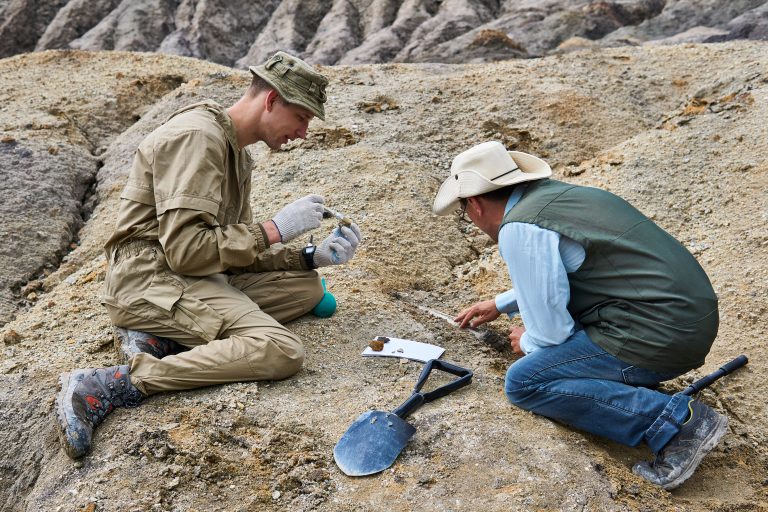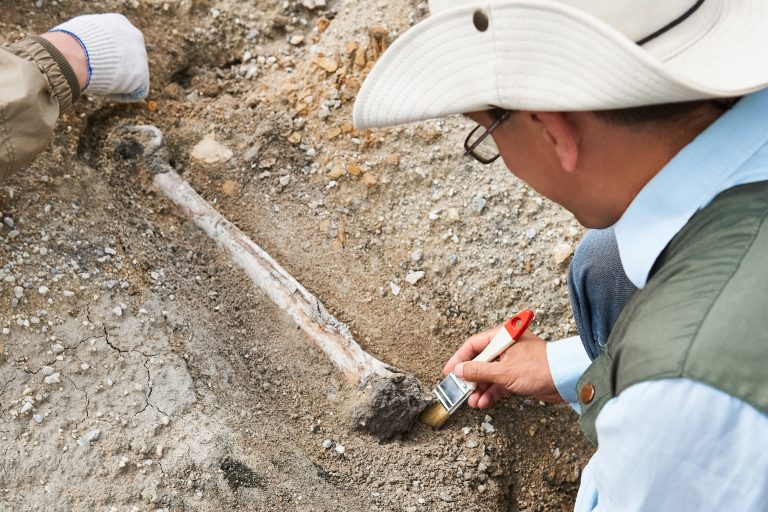9 Unsung Heroes: The People Who Clean Fossils Revealed

Imagine unearthing the remains of creatures that haven’t walked the Earth for millions of years. Now, picture the meticulous work that goes into revealing the full glory of these ancient relics. That’s the world of paleocleaning—a vital but often overlooked stage in paleontology.
Fossil cleaning, akin to history’s bath, delicately removes eons-old dirt from ancient remains. Patience is paramount; one misstep could erase a chapter of our planet’s past. Behind the scenes, unsung heroes tirelessly prepare fossils for scientific study or museum displays.
These meticulous artisans, resembling prehistoric dental hygienists, use various tools to unveil secrets from stone. Precision is key, with each fossil presenting unique challenges requiring a steady hand and a keen eye.
Beyond aesthetics, paleocleaning is vital for revealing anatomical details crucial to understanding ancient life. Without it, the subtleties of prehistoric creatures would remain locked in stone, unseen by researchers and the public.
Hey hey! Don’t forget to subscribe to get our best content 🙂
1. Tools of the Fossil Trade
In the fossil trade, the tools are as specialized as the task at hand. Pneumatic scribes, which resemble miniature jackhammers, allow preparators to chip away rock with high precision. Air abrasion units, which blast powdery aluminum oxide, can gently remove stubborn matrix—the rock surrounding the fossil—like a micro-sandblaster for ancient bones.
But it’s not all high-tech; sometimes, good old-fashioned dental picks and fine brushes are the best choice for delicate work. And let’s not forget the trusty magnifying glass or microscope, which brings the minute details of a fossil’s surface into sharp relief. (Imagine trying to spot the texture of skin on a tiny lizard fossil without one!)
The arsenal of a fossil preparator may also include adhesives and consolidants—special substances used to stabilize and preserve fossils during and after cleaning. It’s a bit like a surgeon having a well-organized tray of instruments, each one crucial for a different step in the operation. And just like surgery, there’s no room for error.
2. The Fossil Cleaning Process
The fossil cleaning process is a dance between science and art. First, preparers assess the specimen to understand its condition and the best approach for cleaning. Then, with the patience of a saint, they begin the painstaking work of removing the matrix. This can take hours, days, or even weeks, depending on the fossil’s size and fragility.
During cleaning, preparators must constantly make decisions, such as how much matrix to leave for support and when to use chemical methods over mechanical ones. They often work in layers, uncovering one small section at a time to avoid damage. It’s like peeling back the layers of an onion, where each layer is a potential discovery or a possible disaster.
The final stage involves consolidating the fossil, ensuring that it doesn’t crumble after being exposed to the air. It’s a delicate balancing act between preserving the fossil’s integrity and revealing as much detail as possible. The goal is to leave the fossil stable, clean, and ready for study or exhibition—looking as though it just stepped out of a prehistoric salon.
3. Meet the Fossil Preparators
Fossil preparators are the unsung Picassos of the paleontology world. With skills honed through years of experience, they transform rough extractions into museum-worthy pieces. These are folks with an eye for detail and a passion for the past—imagine spending your day brushing the cheekbone of a Triceratops or revealing the delicate wing of a prehistoric dragonfly.
Many preparators have backgrounds in art or sculpture, which is no surprise given the finesse required for their work. They’re part scientists, part artists, and entirely dedicated to their craft. (It’s not everyone who can claim their day job involves time-traveling through geology!)
What’s more, these professionals are also educators and storytellers, often sharing their knowledge with the public through workshops and museum demonstrations. They bridge the gap between the field and the display case, bringing ancient stories to life through each fossil they touch.
In the video, The Etches Collection explains –
The Etches Collection
- Fossil preparators play a crucial role in cleaning and preserving fossil materials for museum display.
- The job requires delicate handling and precision as incorrect preparation can damage the fossils irreversibly.
- Individuals often enter this field through self-teaching methods, starting with basic tools like hammers and gradually advancing to pneumatic tools.
- Advanced preparation techniques involve tools such as air chisels, air pens, grinders, and air abrasives.
- Air abrasive tools function like miniature sandblasters and use various abrasive powders, including sodium bicarbonate, dolomite, aluminium oxide, and glass beads.
- Glues play a significant role in fossil preparation, with super glue (cyan acrylic glues) being commonly used in different viscosities.
- Other glues like styrene-based glues and epoxy resins are utilized for bonding larger rocks or consolidating fragile fossils.
- Museum grey consolidant, such as paraloid, is used to consolidate friable fossils, although it’s not preferred for strengthening due to its tendency to wet and destroy fragile objects.
- Preparators ensure that all materials used in fossil preparation are removable, even fiberglass resins used for reinforcing blocks.
- Fossil preparation can be conducted in various settings, from small sheds to large workshops, with equally effective results achievable regardless of the workspace size.
4. Techniques in Detail
The techniques used in fossil preparation are as varied as the fossils themselves. Mechanical preparation involves chisels, air scribes, and even miniature jackhammers. It’s a process that requires a blend of brute force and balletic precision, like a sculptor chipping away at marble to reveal the form within.
Chemical preparation, on the other hand, uses acids or other solutions to dissolve the surrounding matrix. It’s a bit like cooking, where the recipe must be followed to the letter to avoid a culinary catastrophe—in this case, the fossil itself. Preparators must know their chemistry as well as their geology.
Then there are the all-important finishing touches, such as repairing breaks or cracks with adhesives that are as strong as the original bone, yet reversible if future cleaning is needed. It’s the conservationist’s version of a touch-up, ensuring that the fossil is not only clean but also stable and preserved for generations to come.
5. Challenges in Fossil Cleaning

Every fossil is a riddle wrapped in a mystery inside an enigma—and encased in rock. One of the biggest challenges in fossil cleaning is determining how much of the surrounding matrix to remove. Too little, and important details might be obscured; too much, and the fossil could be damaged or weakened.
Another challenge is working with extremely fragile fossils, where the slightest misstep could turn a priceless specimen into dust. It’s like handling a glass sculpture on a windy day—every move is fraught with potential disaster.
And then there’s the issue of time. Fossil preparation isn’t a race; it’s a marathon, with some projects taking years to complete. It requires a level of patience that would make a monk envious, coupled with an unwavering attention to detail. But for those who love it, there’s no greater thrill than revealing a secret that’s been hidden for millions of years.
6. The Art of Reconstruction
Reconstruction is where the magic happens. Imagine piecing together a jigsaw puzzle, except the pieces are fossilized bones, and the picture on the box is a creature no one has seen in millions of years. It’s a blend of scientific knowledge and creative problem-solving, with a dash of intuition thrown in for good measure.
Sometimes, preparators must fabricate missing pieces, using their understanding of anatomy and symmetry to craft replacements that are accurate and plausible. It’s like being a detective, using the clues at hand to solve a prehistoric mystery.
The reconstruction process not only gives us a visual representation of extinct species but also provides critical data for scientific study. It’s the point where a pile of bones becomes a window into the past, offering insights into the behavior, environment, and evolution of ancient life.
7. Preservation and Conservation
Preservation and conservation are the yin and yang of paleocleaning. Preparators must ensure that the fossils are not only clean but also protected from the ravages of time. This means using materials and techniques that won’t harm the fossils in the long run—like a chef choosing the freshest ingredients for a recipe that will be savored for years.
Environmental factors, such as humidity and temperature, can also affect fossils, so careful monitoring and climate control are essential. It’s like being a guardian of history, ensuring that these ancient treasures are safeguarded against the future.
Above all, conservation is about making sure that these fossils can continue to be studied and enjoyed. It’s a commitment to maintaining a tangible link to the past so that future generations can share in the wonder of Earth’s prehistoric heritage.
8. Fossil Cleaning Innovations
The field of fossil cleaning is always evolving, with innovations making the work more efficient and less risky for the fossils. For instance, 3D imaging and printing technologies allow preparators to plan their approach in detail before touching the specimen, or even to create replicas for study while preserving the original.
Advances in chemical preparation have led to more precise and less invasive cleaning methods. It’s a bit like having a new set of spices in the kitchen—you can fine-tune the flavors (or in this case, the fossil details) to perfection.
And let’s not forget about the digital realm, where virtual reconstruction can fill in the gaps of missing or damaged fossils. It’s a brave new world where the bones of the past meet the technology of the future, creating opportunities for research and education that were once unimaginable.
9. Honoring the Hidden Heroes
The people who clean fossils are the hidden heroes of paleontology. They labor in the shadows, yet their work illuminates our understanding of the ancient world. It’s high time we shine a spotlight on these dedicated professionals, acknowledging their vital role in bringing prehistoric wonders into the light.
By honoring fossil preparators, we celebrate the meticulous care and passion that goes into every cleaned, conserved, and reconstructed specimen. These individuals are the bridge between the field and the public, between raw discovery and polished display. Their work is a testament to the power of patience, skill, and an enduring curiosity about the natural world.
Fossil preparators, we salute you. Your work may be painstaking and often goes unnoticed, but it’s essential. Thanks to you, we all get to marvel at the wonders of ancient life, beautifully revealed and preserved for posterity.
The next time you gaze upon a fossil, remember the hands that freed it from its stony prison. Let’s give a round of applause for the fossil preparators, whose artistry and dedication allow us to walk with dinosaurs and fly with ancient birds through the halls of history.






